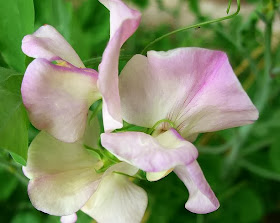Type of Flowers
Sweet Pea:
Sweet pea is a flowering plant in the genus Lathyrus in the family Fabaceae (legumes), native to the eastern Mediterranean.
It is an annual climbing plant, growing to a height of 1–2 meters (nearly six feet and six inches), where suitable support is available. The leaves are pinnate with two leaflets and a terminal tendril, which twines around supporting plants and structures helping the sweet pea to climb. The flowers are purple, 2-3.5 centimeters broad, in the wild plant, larger and very variable in color in the many cultivars.
Henry Eckford (1823–1905), a Scottish nurseryman, cross-bred and developed the sweet pea, turning it from a rather insignificant, if sweetly scented flower, into the floral sensation of the late Victorian era.
His initial success and recognition came while serving as head gardener for the Earl of Radnor, raising new cultivars of pelargoniums and dahlias. In 1870 he went to work for one Dr. Sankey of Sandywell near Gloucester. A member of the Royal Horticultural Society, he was awarded a First Class Certificate (the top award) in 1882 for introducing the sweet pea cultivar 'Bronze Prince', marking the start of association with the flower. In 1888 he set up his development and trial fields for sweet peas in Wem in Shropshire. By 1901, he had introduced a total of 115 cultivars, out 264 cultivars grown at the time.Eckford was presented with the RHS Victoria Medal of Honour for his work. He died in 1906 but his work was continued, for a time at least, by his son John Eckford.
More recently, the association between the sweet pea, the Eckfords and Wem has been highlighted again. In the late 1980s, the Sweet Pea Society of Wem started an annual show and the town has again taken the flower to its heart. Many of the street signs now carry a sweet pea motif and an area of the town is known as Eckford Park. There is also a cultivar 'Dorothy Eckford', named after a family member.
Sweet peas have been cultivated since the 17th century and a vast number of cultivars are commercially available. They are grown for their flower colour (usually in pastel shades of blue, pink, purple and white, including bi-colours), and for their intense unique fragrance. They are grown by gardeners for private consumption or for exhibition, and in the floristry trade. The large, pea-shaped seeds are sown in cold frames in Spring or Autumn. The seeds benefit from pre-soaking or chipping with a sharp blade. The plants are also available later in the season, as young plants or plugs. They are grown up canes, with the new shoots being regularly pinched out to promote a bushy habit and higher flower yields. Plants typically reach heights of 1-2m, with the flowers appearing in midsummer and continuing for many weeks if regularly deadheaded.




















No comments:
Post a Comment